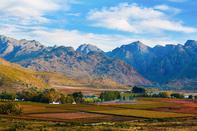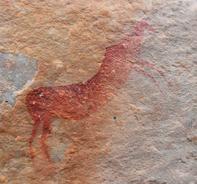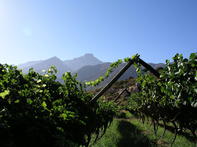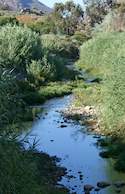Aquifers Galore
The Hex River Valley is both a geological and floral transition zone. The geology of the south-west of the valley is part of the Western Cape’s Fold Mountain complex consisting of Table Mountain sandstone. To the northeast of the valley, this gives way to Bokkeveld Shale and the butte formations typical of the Karoo.

The floral transition is from Mediterranean climate fynbos to the Succulent Karoo flora and follows the same geographic transition as the geological one. These massive mountain ranges create a vast catchment area for the valley enabling growers to produce premium table grapes.
Inhabitants of the valley receive water from mountain streams that have their sources deep in the mountains where during winter the run-off from snow-capped mountaintops seeps gradually down the slopes and into the pristine mountain streams.
The runoff also replenishes the water table in the region’s strong aquifers, which allows for additional water extraction through boreholes. This water contains minerals and organic material which help create the ideal medium for fruit production.
San Spirit

The vast mountainous area is pristine indigenous Fynbos habitat and supports the full range of indigenous flora and fauna. Sightings of klipspringers, porcupines, baboons, mongooses, rock hyraxes and hares are quite commonplace. Although they are more elusive, the area also supports Cape jackals, bat-eared foxes as well as the magnificent Cape Mountain leopard.
The mountains also support an abundant variety of birdlife including large raptors such as black eagles, often seen hunting high above the mountain cliffs. These ranges also contain reminders of the earliest human inhabitants of the valley.
Rock art painted on the cliffs and caves of the mountains has been found to be 7 000 years old and attests to habitation of the area by the /Xam San, the Southern branch of the San tribe of hunter-gatherers.
These were the Western Cape’s original inhabitants and the DNA of the San people has proved them to be the closest living relatives to early man. There is evidence that these prehistoric tribes also used the valley as a seasonal migration route, following the herds of antelope into the Karoo during the winter and returning to the permanent rivers in the Western Cape valleys during the summer.
Today the spirit of the San is still remembered as locals call the cold wind that blows through the Hex River gorge “die boesmantjie”, which translates as the San hunter.
Wars in the Area

The southern entrance to the valley at Sandhills is through the very narrow gorge formed by the Hex River on its course to the south-west.
This part of the route is as spectacular as it is strategic as the main national highway, prime national railroad route and a permanent river all negotiate the gorge entrance, which is only 270 m wide at this point.
The strategic value of this route was recognized during the Boer War as this was the site of a tollhouse constructed to control and monitor the traffic along this route.
For some months during the war, there was also a British garrison posted at the tollhouse. There was clearly a reason for concern as in one instance Boer commando’s did in fact travel as far south to a mere 40 km north of De Doorns.
The area was also influenced by another war as during the Second World War Italian prisoners of war were sent to South Africa.
Farmers had the opportunity to apply to have a group of prisoners assigned to them to live and work on the farms in the district. Several Prisoners of War were placed on farms in Sandhills and elsewhere in the valley for the duration of the Second World War.
X the Original Name

It is in the Sandhills area that the original name for the valley, the Ex (X) River, was coined. One explanation is that the confluence of 3 rivers in the area formed an X shape and the other was that as the road was forced to repeatedly cross the river through the gorge, creating numerous X shaped crossings in the process.
The name was later changed to Hex River and there is a sad and romantic legend attached to this name.
The name Sandhills is a misnomer and is most likely an English corruption of the Dutch name Zanddrift which means sandy river ford.
The northern entrance to the valley by road is down the rapid descent of the Hex River Pass and rewards the traveller with the first spectacular views of soaring mountains and green cultivated landscapes after travelling through the arid Karoo.
By Louise Brodie The Hex River Valley is the gateway between the Western Cape’s Boland region and the coast beyond to the south and the plains of the Great...
The Hex River Valley is the gateway between the Western Cape’s Boland region and the coast beyond to the south and the plains of the Great... This is where it all seems to hang together - the vines, the oak trees, the whitewashed houses and even the red and white roses planted next...
This is where it all seems to hang together - the vines, the oak trees, the whitewashed houses and even the red and white roses planted next...